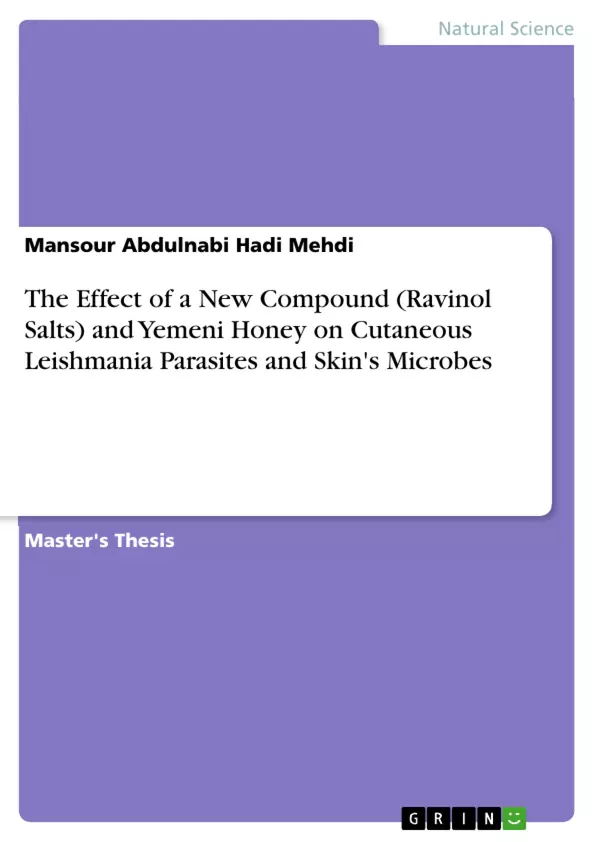Cutaneous leishmaniasis is still a major health problem especially in countries with low socioeconomic development. Although pentavalent antimony compounds are still the expensive, standard, basic and first line of treatment in Yemen. The aim of study: Detection of Leishmania spp patients. Detection of other microbes. Study the antiseptic effect of different concentrations of the 2-ethoxy-6,9-diamino acridinium enzensulphohydrazidooxalyl glycinate and Yemeni Honey (RIV) on a particular strains of microbes in vitro and Leishmania parasite in vivo.
The samples have been collected at the laboratory of the Faculty of Education-Radfan, Aden University. The Cutaneous Leishmaniasis diagnosed clinically parasitology, hematology, and culturing the parasites and biochemically. Moreover, the microbes which are found around the lesions were diagnosed by microscopic, culture and biochemical tests. The venous blood have been collected from 8 patients and 5 controls. The susceptibility of the microbes for some antibiotic found in our pharmacies and the new compound 2-ethoxy-6,9-diamino acridinium benzensulphohydrazidooxalyl glycinate have been studied. Besides, the effect of Yemeni Honey (Sider and Summer) has been studied. Moreover, the animals have been injected with cutaneous leishmaniasis parasite have been studied.
The study has revealed that the age of patients is between 12- 68 years and 4 of them (50%) are males and the other 4(50%) are females. Also the study has showed that most of the patients are young adults live in small villages.
The study has showed that the lesions of 62.5% of the cutaneous leishmaniasis patients are localized on the face, while the lesions of 20% of the patients are in the hands and one case on leg. Besides, it has noticed that all the inoculated rabbits after two-three weeks could develop different types of lesions ranging from nodules to open ulcerated lesions. The smears taken from the patients have showed that are intracellular amastigote, inflammatory cells, lymphocytes, and plasma cells. The amastigote has been found intracellular as well as extracellular.
Inhaltsverzeichnis (Table of Contents)
- Introduction
- Materials and Methods
- Study area
- Parasite collection
- Preparation of Ravinol salts solution
- Preparation of Yemeni honey solution
- Experimental design
- Results
- Effect of Ravinol salts on L. major promastigotes
- Effect of Yemeni honey on L. major promastigotes
- Effect of Ravinol salts on cutaneous leishmaniasis lesions
- Effect of Yemeni honey on cutaneous leishmaniasis lesions
- Effect of Ravinol salts and Yemeni honey on skin's microbes
- Discussion
- Conclusion
Zielsetzung und Themenschwerpunkte (Objectives and Key Themes)
This thesis examines the potential therapeutic effects of a new compound, Ravinol salts, and Yemeni honey on cutaneous leishmaniasis, a parasitic disease that affects the skin. The study aims to evaluate the efficacy of these agents in reducing parasite burden and improving skin lesions. It further investigates their impact on skin's microbial communities, exploring the possibility of synergistic effects.
- Efficacy of Ravinol salts and Yemeni honey against cutaneous leishmaniasis parasites
- Impact of Ravinol salts and Yemeni honey on skin lesions
- Influence of Ravinol salts and Yemeni honey on skin's microbial composition
- Exploration of potential synergistic effects between Ravinol salts and Yemeni honey
- Evaluation of traditional remedies for cutaneous leishmaniasis in Yemen
Zusammenfassung der Kapitel (Chapter Summaries)
- Introduction: This chapter provides an overview of cutaneous leishmaniasis, discussing its epidemiology, transmission, clinical manifestations, and current treatment options. The study's objectives and rationale are outlined, highlighting the need for alternative therapies to address the limitations of existing treatments.
- Materials and Methods: This chapter describes the study design, including the collection of parasites, the preparation of Ravinol salts and Yemeni honey solutions, and the experimental procedures used to assess the efficacy of these agents against Leishmania parasites and skin microbes.
- Results: This chapter presents the findings of the study, detailing the effects of Ravinol salts and Yemeni honey on Leishmania parasites, skin lesions, and skin's microbial composition. It analyzes the data gathered from different experimental groups and discusses the observed trends.
- Discussion: This chapter interprets the findings in relation to previous research and explores the mechanisms underlying the observed effects. It discusses the potential implications of the study's results for the management of cutaneous leishmaniasis and emphasizes the need for further research.
Schlüsselwörter (Keywords)
Cutaneous leishmaniasis, Leishmania major, Ravinol salts, Yemeni honey, parasitic disease, skin lesions, skin microbiota, antimicrobial activity, traditional medicine, therapeutic potential, Yemen.
- Quote paper
- Mansour Abdulnabi Hadi Mehdi (Author), 2013, The Effect of a New Compound (Ravinol Salts) and Yemeni Honey on Cutaneous Leishmania Parasites and Skin's Microbes, Munich, GRIN Verlag, https://www.grin.com/document/450259



